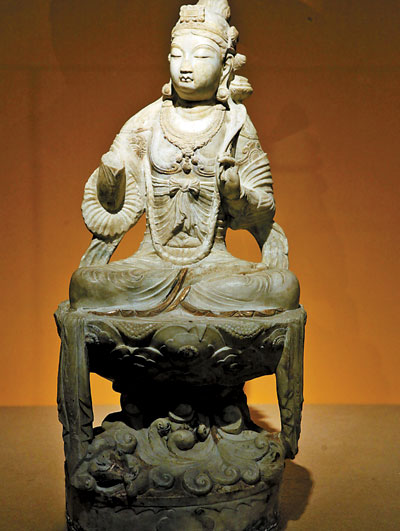
Cao Zhen caozhen0806@126.com LAVISH Tang Dynasty (618-907) relics from Famen Temple in Baoji City, Shaanxi Province, are on display at an exhibition at Shenzhen Museum’s Civic Center branch. The relics were unearthed in 1987 from the underground palace of True Relic Pagoda in Famen Temple, which is renowned for housing finger bones of the Buddha. Most of the relics are officially prohibited from exhibiting abroad. The objects at the Shenzhen exhibition include three cases from the Eight-case Container, teaware and porcelain and a replica of a 12-ring khakkhara. The Eight-case Container, which was found in the back chamber of the underground palace, used to contain finger bones of the Buddha. The container was constructed out of eight cases of decreasing size placed one inside another, similar to a matryoshka doll. The outermost case was made of sandalwood and had rotted away. The seven interior cases were either gilded with silver or gold and were in a good state of preservation. Some of them were carved with pictures of Buddhist tales. The innermost case was a four-door miniature pagoda with a single-tier eave. The finger bone was hollow and set on a silver bar inside the gold mini-pagoda. Among other relics found at Famen Temple were gold and silver objects, such as incense burners and fragrance balls, as well as silk products, used by the Tang imperial household. At the exhibition, a silver 12.8-cm-diameter fragrance ball sits on display along with a replica of the 12-ring khakkhara. The original staff was made in 873 for Emperor Yizong to use when worshipping the finger bones of the Buddha. At 1.96 meters long, 2.3 kg in weight and adorned with 12 gold rings on top, the staff makes for an impressive and unique artifact. A monk staff, khakkhara, is a Buddhist ringed staff used primarily in prayer or as a weapon that originated in India. It may have either four rings representing the Four Noble Truths, six rings representing the Six Perfections, or 12 rings representing the twelvefold chain of cause and effect. A four-ring khakkhara is carried by novice monks, a six-ring khakkhara is carried by a Bodhisattva, and a 12-ring khakkhara is carried by the Buddha. Another important find in the temple is the porcelain produced exclusively for the imperial household. According to historical records, this kind of porcelain is “sky blue, shiny as a mirror, and rings like a chime.” The process of its making and firing was kept secret and the products were never seen outside the imperial court, hence it is termed “mystical colored porcelain.” The art of making this secret porcelain was lost after the Tang Dynasty. Stone bodhisattva statues unearthed from Anguo Temple in Shaanxi Province in 1959 are also on display at the exhibition. Dates: Until Feb. 28 Open: 9:30 a.m.-5:30 p.m., closed Mondays Venue: Shenzhen Museum, Block A, Civic Center, Futian District (福田区市民中心A区深圳博物馆新馆) Metro: Line 2 or 4, Civic Center Station (市民中心站), Exit B | 
